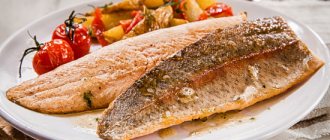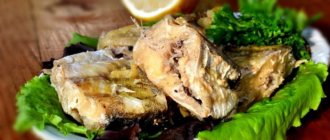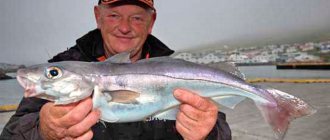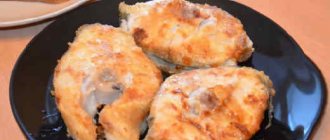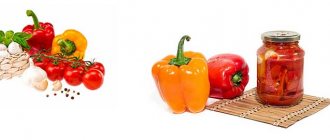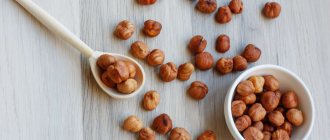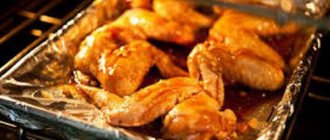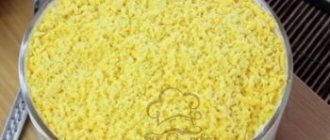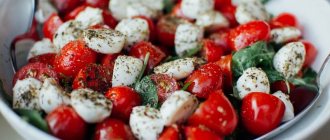Fish and meat protein
Most types of river fish contain fewer calories than lean meat, while their protein is of good quality and amino acids are absorbed much faster. At the same time, you ate a large fried piece of fish, you feel full and satisfied, but you consumed many times fewer calories. That's the advantage.
Fish protein contains little connective tissue in the form of collagen, which, when digested, turns into glutin. When cooked, these tissues lose strength and are absorbed by the body almost 100%, in contrast to meat protein, which is broken down by less than 90%.
As for the healthiest method of cooking, it goes without saying - boiling!
This way you will preserve the most beneficial qualities of the fish, while it will not receive additional fats in the form of oil.
For example, boiled catfish has a calorie content of one hundred fourteen kilocalories per hundred grams of product, flounder - one hundred three, bream - one hundred twenty-six, pollock - seventy-nine, burbot - ninety-two, sturgeon - one hundred seventy-nine, halibut - two hundred sixteen, mackerel - two hundred eleven, pike perch - ninety-seven, cod - seventy-eight, hake - ninety-five and pike - ninety-eight kilocalories.
Baked pink salmon
Before baking, it is recommended to soak pink salmon in some sauce with spices and send it to the oven, wrapped in foil. Then the finished dish will be tender and juicy.
It is possible to significantly reduce the calorie content of pink salmon baked in the oven if you use regular kefir instead of cream and mayonnaise. For 1 kg of fillet you will need 100 g of kefir, lemon, salt, ground pepper and other spices.
Rub the pieces with spices and salt, pour kefir and lemon juice and marinate for at least half an hour. Cover a baking sheet with foil, place thin lemon slices on it, and fish on top. Place potato mugs between the pieces. Pour marinade over everything, cover with foil and bake for 40 minutes at 220°C. For beautiful browning, remove the top layer of foil five minutes before cooking.
Fish diet
If you want to not only include fish in your diet, but also follow a fish diet, we will bring to your attention the following version of the fish diet.
It is recommended to follow such a diet for about ten days, no more.
To create your menu, consider the option below.
So, in the morning you are allowed to drink two mugs of tea (preferably green and definitely without added sugar), then a glass of low-fat natural yogurt, eat one or two boiled eggs, and at the very end of the meal, eat one ascorbic acid tablet.
During lunch
(This is what our second breakfast is called) you can drink a lot of clean water, eat some boiled fish with raw vegetables in the form of a salad or simply cut into slices. Give preference to green vegetables. In addition, you can eat some fresh fruits.
At lunchtime
You can eat up to 250 grams of cooked fish in any way (just not boiled, because we already ate it in the previous meal), and use vegetables as a side dish. We wash down our food with two mugs of clean water. You can also eat a jar of low-fat natural yogurt or lemon juice diluted with water.
Advantages and disadvantages of fried fish and how best to cook it
If you take a certain variety and cook it in two ways, for example, steamed and fried, then in the first case the calorie content will be lower than in the second. But if you are struggling with excess weight and you prefer fried fish rather than boiled fish, then don’t look at the calories, regardless of them, such a delicacy helps burn fat and helps you become slimmer. During frying, high heat treatment occurs, which destroys all possible parasites present in river fish, so this is not only a tasty, but also a safe method of cooking.
You need to be able to properly cook fish in order to preserve beneficial vitamins and microelements in it. The most useful in terms of the amount of substances will be fresh fish. During heat treatment, beneficial substances disintegrate, so in fried food there will be fewer of them than in boiled food. Fish is a unique product, despite the widespread belief that everything fried is harmful to the body, because it has a lot of calories, 100 grams on average 140 Kcal, and this is due to the vegetable oils used in cooking.
List of varieties that can be considered the most dietary and low-calorie
Fish that is suitable for the diet can be either sea or river, the main thing is low calorie content.
Fact! However, despite the calorie content, sea fish is considered more useful. This is due to the fact that it has a higher content of Omega-3 and Omega-6 fatty acids and a richer mineral composition. This is especially true for iodine. There is much more of it in sea fish than in river fish. And a significant part of the population needs additional iodine, because many people suffer from iodine deficiency to one degree or another. The problem is especially pressing for residents of mountainous areas. Regular consumption of sea fish will normalize the level of iodine in the body. In addition, sea fish are many times less susceptible to infection by parasites than river fish. This is due to the fact that much fewer types of parasites survive in salt water than in fresh water.
The list of dietary varieties may include:
- cod (69);
- pollock (72);
- haddock (73);
- blue whiting (82);
- pike (84);
- hake (86);
- flounder (90);
- carp (97);
- bream (105).
Preserves
Proper nutrition is one of the components of health, but you should not approach it too radically. Chips, fast food, beer are, of course, harmful, but how sometimes you want to “harm” yourself! Even if you can’t, even if you’re on a diet, even if your figure will suffer and there’s a panicky fear of adding a few millimeters to your waist.
A Champions League match, a game of your favorite club, or just a good movie with friends - how can you not drink a bottle or three of beer while doing this? And what could be a better snack for beer than dried salted fish?
The calorie content of this product is a parameter that only a few know. Everyone thinks that there is no benefit from it, but how “useless” it is - what difference does it really make? Let's look at how many calories everyone's favorite salted dried fish contains, and will it do much harm if “a little bit”?
On the Dukan diet
This famous nutritionist often includes seafood in his menu. On the Dukan diet, he recommends eating fish with the thickest flesh. He argues that varieties with soft meat do not satiate well, are digested too quickly and you want to eat again. Some varieties that have a high fillet density are well suited for the Dukan menu:
- Sea bass. It can be baked in the oven or on the grill.
- Angler. This is a tasty fish with a dense fillet, reminiscent of beef. It is better to steam the devil for 40 minutes; first you need to marinate with herbs in lemon juice.
- Tuna. The fish is baked in a sleeve or grilled. You can use canned food in its own juice; it goes perfectly with any side dish from the diet menu or with vegetables.
How many calories are in salted dried fish?
No matter how much one would like to operate only with exact numbers and data, this is simply impossible. All fish are different, and their calorie content, accordingly, is also different. If we take the average value, then the calorie content of salted dried fish is 275 kC per 100 grams of product . A lot of? If you like sandwiches with butter, then for you this figure is a drop in the ocean, because 100 grams of butter contain 717 kC! Ordinary sunflower seeds are 584 kC for the same 100 grams. But these are the most common foods that many eat regularly.
If we consider the calorie content of salted dried fish of different types, the data will be approximately as follows:
Yellow minke whale – 267 kC
Dried pollock straws – 237 kCl
These are the most popular and affordable types of salted dried fish, the calorie content of which may be of interest to many. As you can see, not a single species can even closely compare in caloric content with the same butter or sausage, which has an average of 300 kC per 100 grams.
Smoked and salted fish have slightly different caloric content.
For example, red fish is not low in calories.
Pink salmon contains about one hundred and sixty-nine calories.
There are two hundred and twenty seven in trout.
Salmon contains two hundred and forty kilocalories per hundred grams of product.
Herring is the owner of one hundred and forty-five kcal.
Mackerel in the region of one hundred and fifty.
Sprat has one hundred and fifty-four kilocalories per hundred grams.
But smoked cod, say, has only one hundred and fifteen kilocalories.
You can if you are careful enough
Salted dried fish, the calorie content of which we have examined, usually serves as a snack for beer, which is clearly not the healthiest product. It follows from this that if you drink beer occasionally (the same Champions League matches do not take place every day), then you can eat fish without fear. Preservatives, low-quality spices and other additives that some manufacturers add can cause you much more harm.
Well, if you buy a high-quality product from those presented in our company’s catalog, then you won’t have to worry about calorie content and safety at all!
Fish is quite low in calories when compared to meat.
Unlike meat, it is also much more nutritious. In view of the fact that many people today are trying to eat healthy and try to keep their weight under control, fish is just a godsend for them!
Another obvious advantage of fish is that it has much more benefits than, say, meat. In addition, it is digested in our body faster and better. You shouldn’t mindlessly fill your stomach with food that will make you eat faster and more satisfyingly. Your body needs, first of all, carbohydrates, fats and proteins, minerals and vitamins, otherwise, if all this is lacking, your body will begin to get sick often.
High-calorie fish. Calorie content of fish - a guide for losing weight
Nowadays, many people pay a lot of attention to what they eat. In other words, healthy eating is becoming increasingly popular. People pay attention to the usefulness of products, as well as their energy value. In principle, this is correct. This makes it easier to control your weight, which is an important component of our health and beauty. Regular consumption of fish (twice a week) helps to significantly reduce the risk of coronary disease, as well as strengthen the human immune system.
How many calories are in fish?
By all accounts, not enough. Indeed, in comparison with meat, it looks like a much lighter food. At the same time, fish is very useful. It contains a lot of protein, minerals, and vitamins. It is absolutely irreplaceable in the diet. The number of calories in different types of fish varies. At the same time, a lot depends on the method of its preparation. For example, do you know how many calories are in fish per serving (100 grams)? So, burbot - 65, pollock - 70; Atlantic herring - 57; pike and pike perch - 72 each; cod - 59; hake - 86; horse mackerel - 119; flounder - 90; capelin - 157; pink salmon - 147; tuna - 296. This is if we are talking about raw or steamed fish. However, as a result of additional processing, the fish becomes more nutritious.
Many people think about how many calories are in fish when they need to lose weight. With the help of fish you can easily lose several kilograms. There is a special diet designed for 10 days. By following all the conditions, you can lose from 3.5 to 5 kilograms of excess weight. You should drink 1.5 liters of clean, unsalted water per day.
Breakfast - 2 cups of green tea, one or two eggs, a glass of kefir or low-fat yogurt, maybe cottage cheese, plus one tablet of ascorbic acid. Lunch - a glass of water, a portion of boiled fish with raw vegetables, you can eat any fruit. Lunch - 2 glasses of water, 250 grams of fish in any form, a side dish of vegetables (except starchy ones), you can add a little low-fat yogurt or lemon juice. Dinner - the same menu as during lunch.
Potential danger
People prone to allergies should be wary of this food.
Those who suffer from kidney disease should pay increased attention to the state of the body, especially if they suddenly want dried or salty foods.
There are also dangers that may arise when eaten:
- this river inhabitant is often infected with parasites, many of which are dangerous to humans;
- it is relatively bony, and even fatal cases of bone damage to the digestive system have been reported. When eating, you should be careful and careful.
Nutritional value of sea and river fish
Fish is a source of omega-3 unsaturated fatty acids, which are essential for the functioning of the human brain and heart. This product contains two fatty acids, timnodonic and cervonic, which are of great value for the human body. They are absent in vegetable fats (with the exception of fats obtained from certain types of algae), but are found in animals, especially in the fat of marine life. These acids prevent obesity, are useful for cerebral circulation, and prevent visual impairment. Omega-3 fats are essential for:
- maintain heart health,
- lower pressure,
- prevent the occurrence of arrhythmia,
- prevent strokes,
- reduce the risk of Alzheimer's disease, dementia and diabetes,
- prevent the development of arthritis.
Fish products are rich in calcium, phosphorus and other minerals:
The reduced cholesterol and fat content in some types of fish is compensated by the increased amount of protein in them. The human body requires daily replenishment of protein because it is not stored in reserve in the body.
Fish oil is vital for normal brain development in unborn children and early infants.
Cooking methods affect how many calories the fish will remain after it is processed. For example, boiled pike perch or hake contains only 80-100 kcal. And these same varieties, fried or blanched in oil, contain 200-300 kcal.
The calorie content of dried fish, for example, bream, is 221 kcal, and boiled bream contains 126 kcal per 100 g of product.
Salting fish affects its nutritional value. Thus, fried herring contains only 161 kcal, and the calorie content of salted fish is already 217 kcal per 100 g.
River fish, compared to sea fish, contains few calories, so dietary dishes are often prepared from it. The proteins contained in it are easily digested and converted into proteins.
Fish contains vitamin D, which strengthens the skeletal system, and methionine, which prevents the deposition of fat in the human body. Many varieties contain substances that prevent the development of pathologies. For example, carp is recommended to be consumed to prevent thyroid diseases. Pike is not only a dietary product that contains 3% fat, but also an antiseptic that increases human defenses.
Food-list
By drying we mean a type of cold drying of products of organic origin, during which the dried material is dehydrated at temperatures up to 40 degrees. This temperature regime is lower than the thermal denaturation of the proteins of the feedstock under the influence of sunlight.
As a rule, in dry, windy weather, fish meat is well dried in just two to three days. But depending on the weather conditions and the size of the fish, the duration of drying can exceed two weeks. High-quality dried fish is characterized by a moisture content of less than 38%, clean scales, light salting (up to 10%) and fatty meat.
Drying is most typical for the following types of fish: ram and roach (often in common parlance these words are used in relation to dried fish in general), carp, shemai, vimba, as well as Asian smelt. It is customary to use drying to prepare the belly parts (teshi) and back parts (balyki) of salmon fish (nelma and white fish), sturgeon fish (stellate sturgeon and sturgeon), and whitefish (muksun and omul).
Signs of high-quality dried fish include such indicators as intact scales, natural color, dry belly and gills, and a firm back. The calorie content of dried fish directly depends on the nutritional value of each specific subspecies of waterfowl. When preparing dried fish dishes, meat that has been pre-soaked in salted water is used. Typically, dried fish meat is stewed or boiled.
The benefits of dried fish
Small fish, which are often eaten dried or dried with bones, are a rich source of calcium. Moreover, small specimens of fish not only have better taste, but also greater value: the benefits of dried fish lie in the content of phosphorus and fluorine, which protect our teeth from possible damage.
In addition, the benefits of dried fish as an assistant in the fight against cancer are known. The fact is that, according to research by scientists from Norway, omega-3 polyunsaturated fatty acids, which are present in fatty types of dried fish and fish oil, can destroy cancer cells.
Harm of dried fish
Meanwhile, damage to dried fish is possible when purchasing this valuable product from your hands - it is likely that you become infected with an intestinal disease - diphyllobothriasis. Only in production are absolutely safe dried products produced, since it is there that the fish undergoes a very important stage of preparation - shock freezing or thoroughly salted.
However, even factory-dried fish is not immune from spoilage. For example, if its belly has turned yellow and the fish has an unpleasant odor, then they are offering you a spoiled product. It is no longer possible to consume such dried fish due to oxidation products, ketones and aldehydes, which are carcinogenic substances.
Source
How many calories are in boiled, fried, baked fish?
During the cooking process, you can reduce the calorie content. For example, when baking or cooking fatty varieties of sea and river inhabitants, their energy value decreases. For therapeutic and dietary nutrition, gentle heat treatment methods are used:
- Steam. Nutritionists advise using this method, because with this processing of the product all the beneficial substances in the fish remain. The absence of oil and waste fat promotes weight loss and has a good effect on the body of people with problems with the gastrointestinal tract. 100 grams of, for example, steamed salmon contains 101 kcal.
- Baking in foil. The calorie content of a product prepared in this way is higher than that prepared under the influence of steam. The energy value of red fish baked in foil is 197 kcal. And this steamed product contains 121 kcal.
- Grilling. Exposure to smoke and fire has a beneficial effect on the product. An open fire helps preserve the maximum amount of nutrients. Thanks to heat treatment, fish meat is tender and juicy. Calorie content increases slightly, but remains within acceptable limits. For example, steamed red fish has 121 kcal, and grilled steak has 155 kcal.
The worst option for preparing the product is frying. Substances released during the frying process negatively affect the heart, liver, and stomach.
Comparative table of calorie content of fried and boiled fish.
| Variety | Fried | Boiled |
| Pollock | 136 | 79 |
| crucian carp | 121 | 102 |
| Silver carp | 179 | 86 |
| Carp | 196 | 102 |
| Perch | 180 | 112 |
| Hake | 105 | 95 |
| Pike | 126 | 98 |
Dry fish is very popular. This is a traditional beer snack with a unique taste and originality. The calorie content of dried fish is affected by the varieties from which it is prepared, the drying method and the amount of salt. River species are more often salted and dried, they are less caloric, and in a dry form their energy value does not increase much. On average, 100 g of dried fish contains 250-270 kcal.
Is fatty fish harmful or beneficial?
There is also a classification based on fat content.
- Skinny types. This is, for example, cod. Fat content less than 2%.
- Medium fat content. Fat up to 8%.
- Fatty. Up to 15%. This is sturgeon, salmon.
- Particularly fatty, with a fat layer of more than 15%. These include halibut and eel.
Fish oil is a healthy and valuable product. Especially for children. It contains a large amount of vitamins A, D and fatty acids.
Carbohydrates in fish are represented mainly by muscle glycogen, which, when broken down, gives some varieties a sweetish taste.
Allow yourself to eat fatty fish in small quantities, at least once a week. You are unlikely to gain weight from one serving, but you will be recharged with useful substances.
The calorie content of fish is the sum of the proteins, fats, carbohydrates it contains and their ratio to each other. The average result is approximately 88 kilocalories per 100 grams. product. These are flounder, ruffes, herring and other river fish. There are also high-calorie specimens (halibut - 196.1 kcal per 100 g). Haddock and pollock have only 73 kcal each.
Baked fish is the second healthiest fish after boiled and steamed fish. The calorie content of baked fish can only be increased by the presence of a variety of sauces or vegetables. In this table you can see what calorie content a variety of fish will have depending on the type.
| baked fish | squirrels | fats | carbohydrates | calorie content |
| pink salmon | 20, 36 | 6,5 | 139 | |
| carp | 18,3 | 11,6 | 196 | |
| som | 16,0 | 4,8 | 103 | |
| pollock | 17, 1 | 1 | 79 | |
| salmon | 20 | 13,5 | 200 |
The calorie content of dried fish increases significantly. In addition, when dried, all the beneficial substances in it are practically killed, so it is impossible to classify it as a healthy diet. In addition, when drying fish, salt is added, which is also harmful to the body. Thus, 100 grams of dried whiting contains 249 kcal, carp 87, and yellow minke 262 kcal. in anchovy 259.
Table of calorie content of fish per 100 g
Fish products have an undeniable advantage over other types of products containing proteins and microelements. Low calorie content and easy digestibility allow them to be used in various medical and dietary dishes.
Table of calorie content of fish, some types, per 100 grams of product.
| Fish (fresh) | Calorie content |
| Herring | 161 |
| Mackerel | 191 |
| capelin | 157 |
| Pink salmon | 141 |
| Salmon | 142 |
| Salmon | 140 |
| Sea bass | 79 |
| Pollock | 72 |
| Carp | 112 |
| Pike | 98 |
| River trout | 97 |
| Zander | 84 |
| Bream | 105 |
| white cupid | 134 |
The largest amount of calories is in fish that has gone through the drying process. Its nutritional value increases by 25% compared to boiled. Dried fish, its calorie content, depends on the processing method: hot or cold. When dried by the first method, few useful substances are retained in it, while during the cold drying method all useful substances are preserved.
Salted salmon on a diet. Salmon
Salmon is a delicious species of red sea fish of the Salmon family. It has a very delicate and delicate taste, the meat is juicy, but does not have a pronounced fishy aroma. There are many ways to prepare this wonderful and healthy fish, because it is often spoken of as a product whose taste is practically impossible to spoil. In addition to the fact that salmon is consumed lightly salted or smoked, many light snacks, salads, and sauces are prepared from it; Fresh salmon is added to soups, baked in the oven, fried, grilled, or marinated.
Composition and beneficial properties of salmon
It should be noted that the beneficial properties of salmon have been appreciated for a long time, because this is no coincidence. This fish occupies a leading position in the content of useful substances, compared to other types of fish. Salmon is enriched with valuable proteins, polyunsaturated fats and fatty acids, 22 microelements and vitamins, including vitamin A, D, C, PP, H, phosphorus, potassium, magnesium, chlorine, sulfur, iodine, etc.
Soaking and drying
After two days, the resulting brine (brine) should be drained. Bream must be soaked in water to remove excess salt. There are different points of view on this matter. Some professionals advise soaking the fish for the same number of days as it was salted. There is a recommendation to soak for 10 hours. It is important to drain the water at least three times during the process.
Then comes the turn of the next stage - drying.
Bream should be hung in a cool room (basement, attic, balcony). A gauze canopy can be used as protection against insects.
Under no circumstances should bream be left to dry immediately after salting! Such a dish will simply be impossible to eat. To soak, you need to immerse the carcasses in clean water for a certain time, according to the rules - this is the salting time (if the fish has been salted for 2 days, then it must also be soaked for 2 days). However, often at home 12-15 hours are enough.
For drying, special dryers are used in which the fish are hung. How to make it at home? It is not necessary to buy the installation at a high price; at home, you can hang bream near the gas stove or on the balcony in the warm season. Do not forget about protecting the product from insects that carry parasite eggs.
The recommended temperature for drying fish is no more than 20 degrees. It will dry for 1 to 4 weeks, depending on the size and weight of the carcasses, as well as salting. The ideal dried bream is considered to be a product on which no salt appears. The meat of such fish is covered with dry yellow fat, but the dried bream itself is soft and elastic. It is possible to improve the taste by placing the finished product in the refrigerator for a while.
Drying fish is not difficult, but it is important to know the rules. If you follow simple recommendations at all stages of preparation, dried bream at home will turn out tasty and healthy. So, the process consists of preparing carcasses, salting them, soaking them and drying them. Not a single step should be skipped, otherwise the quality of the dish will greatly deteriorate.
